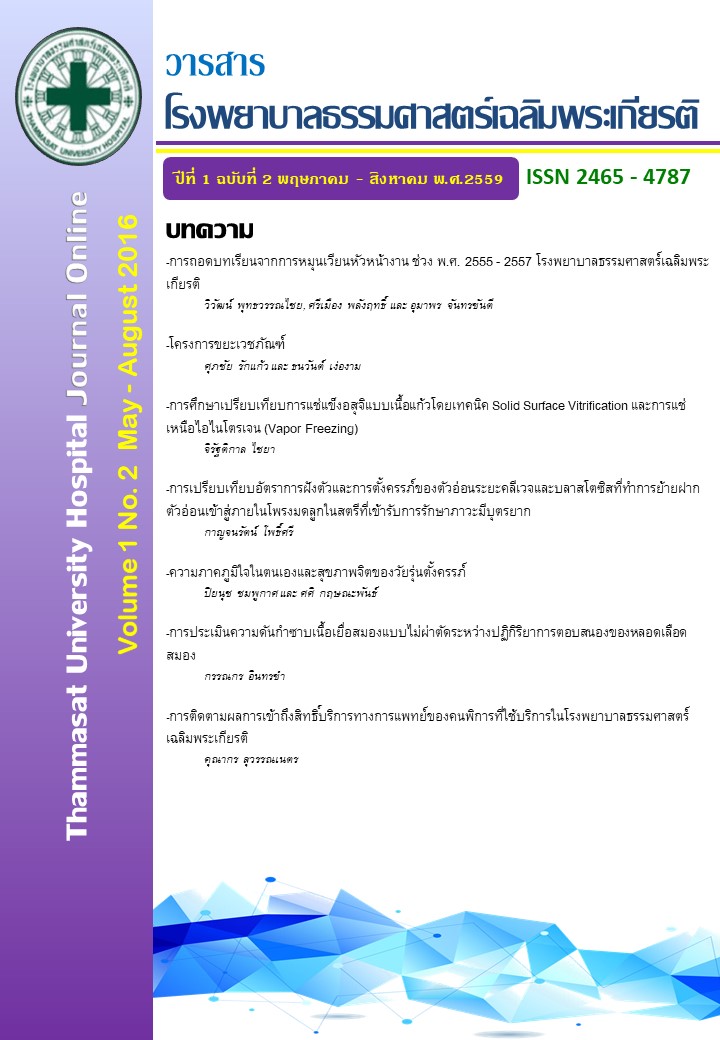Estimation Noninvasive Cerebral Perfusion Pressure during Cerebrovascular Reactivity
Keywords:
estimated cerebral perfusion pressure, zero flow pressure, cerebrovascular reactivityAbstract
Cerebral perfusion pressure (CPP) and zero flow pressure (ZFP) are mostly important in the cerebral circulation system. In the method, noninvasive techniques of estimating CPP and ZFP using transcranial Doppler (TCD) have been described. There are the rare of normal physiological study related to response in estimated CPP (eCPP) and ZFP induced by cerebrovascular reactivity (breath holding). 16 healthy participants were studied to the effects of CO2 when breath holding 30 seconds on eCPP and ZFP. In the basal phase measurement of middle cerebral artery (MCA) for mean cerebral blood flow velocity (mCBFV), blood pressure, pulse and oxygen saturation, all participants voluntarily breath hold to induced hypercapnia, and then they were recorded at each phase. The eCPP and ZFP were calculated by using established formulas, and the results were analyzed with Wilcoxon rank signed test and Spearman rank correlation coefficient (r), mCBFV and eCPP increased from 59.81 ± 11.61 to 76.62 ± 12.78 cm/s and from 55.73 ± 14.56 to 61.01 ± 19.90 50.67 mmHg respectively, with ZFP a corresponding decreasing of ZFP (33.00 ± 13.24 vs 18.13 ± 17.57). These results indicated to behavior of normal physiological response to changing in eCPP and ZFP which can be expected from cerebrovascular reactivity in participants without any neurological disorder. We will apply this protocol and results for eCPP and ZFP in small artery stroke.
References
Burton, A. C. (1951). On the physical equilibrium of small blood vessels. The American journal of physiology, 164(2), 319-329.
Hancock, S. M., Mahajan, R. P., & Athanassiou, L. (2003). Noninvasive estimation of cerebral perfusion pressure and zero flow pressure in healthy volunteers: the effects of changes in end-tidal carbon dioxide. Anesthesia & Analgesia, 96(3), 847-851.
Kety, S. S. (1950). Circulation and metabolism of the human brain in health and disease. Am J Med, 8(2), 205-217. doi: 0002-9343(50)90363-9 [pii]
Markus, H. S., & Harrison, M. J. (1992). Estimation of cerebrovascular reactivity using transcranial Doppler, including the use of breath-holding as the vasodilatory stimulus. Stroke, 23(5), 668-673.
Tiecks, F. P., Lam, A. M., Matta, B. F., Strebel, S., Douville, C., & Newell, D. W. (1995). Effects of the valsalva maneuver on cerebral circulation in healthy adults. A transcranial Doppler Study. [Research Support, Non-U.S. Gov't Research Support, U.S. Gov't, P.H.S.]. Stroke; a journal of cerebral circulation, 26(8), 1386-1392.
Weyland, A., Buhre, W., Grund, S., Ludwig, H., Kazmaier, S., Weyland, W., & Sonntag, H. (2000). Cerebrovascular tone rather than intracranial pressure determines the effective downstream pressure of the cerebral circulation in the absence of intracranial hypertension. Journal of neurosurgical anesthesiology, 12(3), 210-216.


